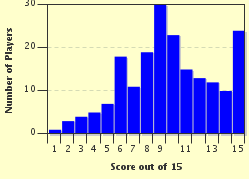Quiz Answer Key and Fun Facts
1. This musical story was written in the early 40s about a rather overweight brass instrument. The most popular version was recorded by Danny Kaye in 1947 using his great ability to produce a range of voices. What is the name of the story?
2. Danny Kaye probably produced more classic music for children than anyone else. Some of it came from a film he made about a famous writer of fairy tales. What is the name of that writer?
3. Frank Crumit recorded a song called "Granny's Old Armchair" in 1929 which became a favourite and told the story of how the inheritance of the old armchair turned out to be a treasure chest rather than a white elephant. How much money fell out of it at the end of the song?
4. For this question we make a short hop from "Granny's Old Armchair" into the Hall to "Grandfather's Clock" by Harold Williams. What did the clock do when grandfather came home with a "blooming and beautiful bride"?
5. Train songs are an area of popularity for children and "The Runaway Train" is a real classic. What line was the train on when it ran away?
6. On the theme of trains a song from the mid 50s was much in demand, too. "The Railroad Runs Through the Middle of the House" tells the tongue-in-cheek story of a railroad company laying a track that split a house in two. The version asked for by kids in Britain was by "the girl with the laugh in her voice". Who was she?
7. Like many other favourites this one is a story with music. It is "The Three Billy Goats Gruff" by Frank Luther. Please tell me how many heads did the evil Troll have in this version?
8. This song has become the theme song for The Walt Disney Company and was first sung in the 1940 film "Pinocchio" by Cliff Edwards. Which character sung "When you Wish upon a Star" in this film?
9. Disney films supplied many of the most requested children's songs and another one of these was "Dumbo" which was issued a year after "Pinocchio" in 1941. The song from it was "When I see an Elephant fly", once again sung by Cliff Edwards. As before, which character did he voice in this film?
10. While we are on the subject of elephants there was another perennial favourite of the time. "Nellie the Elephant" by Mandy Miller was played time and time again. Where did the circus escapee, Nellie, meet the "head of the herd" who called her from far away? She might have run into Kipling there too!
11. It would be impossible to have a selection like this without mentioning "The Teddybears' Picnic" by Henry Hall and his orchestra. At what time did the teddybears' mummies and daddies come "To take them home to bed"?
12. Continuing with the bear theme, there have been several versions of "Me and my Teddybear". The two versions most played for children of the period were by Rosemary Clooney and someone known as the King of the Cowboys. Who was he?
13. Often singing cowboys produced recordings that were loved by children and if you combined them with Christmas you would most likely have a surefire hit. In 1949 "Rudolph the Red-nosed Reindeer" by Gene Autry was just that. "There were Dasher and Dancer and Prancer and Vixen, Comet and Cupid and ...". What are the names of the other two reindeer that Rudolph guided through the fog.
14. Again in 1950 Autry had another Christmas classic that kids love. It was the tale of "Frosty the Snowman". What caused him "to come to life that day"?
15. "Goodnight Children, Everywhere" was recorded by Ambrose and his orchestra in 1940. However, the singer went solo a few months later and became known as "The Forces' Sweetheart" during WWll. Who is she?
Source: Author
baker13
This quiz was reviewed by FunTrivia editor
ertrum before going online.
Any errors found in FunTrivia content are routinely corrected through our feedback system.

